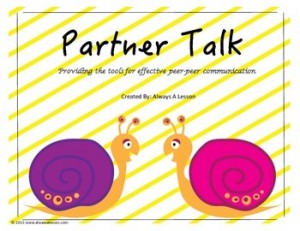A Classroom A Buzz with Partner Talk!
I recently shared a video on my fan Facebook page from The New Teacher Project about a new teacher rolling out a Turn-and-Talk; a procedure used in class to encourage student engagement and collaboration as outlined by Doug Lemov in his Teach Like a Champion book of teaching techniques. A Turn-and-Talk is a simple process where students are pre-assigned a nearby partner to turn to and talk with throughout the day when prompted by the teacher during a lesson.
Watch the video here to see how to roll out this simple procedure to your students.
As a teacher, I began using Turn-and-Talks religiously in my lessons on a daily basis. It gave me a moment to step back and hear from students about what they were learning. This was a self assessment for me- How clearly did I convey content? How deeply do they understand the main message of today’s lesson? What knowledge gap exists?
As a new teacher coach, I modeled this process numerous times for teachers. They appreciated the moment to reflect, privately address a behavior problem, or grab materials at a nearby table. I pushed new teachers to not only use the Turn-and-Talk as a transition technique or time filler activity, but rather use it to better understand student misunderstanding before moving further into a lesson. To better gauge whether students were understanding content, teachers needed to see and hear more from their students. We needed a structure for this.
Luckily, I had been using a Stop-and-Jot method in addition to Turn-and-Talks in my classroom. So I modeled how to adjust the current Turn-and-Talk procedure to allow for students to jot before diving into conversation. Now student engagement increased to 100% because each student had to reflect first on the content before sharing out with a partner. This eliminated one partner doing all the cognitive lifting during a discussion. New teachers quickly implemented the Stop-and-Jot method prior to Turn-and-Talks and gained numerous insights into student thought processes and misconceptions. Student achievement began to climb.
It can be intimidating to watch an experienced teacher utilizing these techniques interchangeably throughout a lesson so effortlessly. The students seem to know who to talk to, what level to speak, how long to discuss, what words to use to agree or disagree, and even how to summarize each other’s points.
How do I get my new teachers to set up such a system? I wondered.
Enter the Partner Talk mapping system! I created a product to structure this process for students to Stop-and-Jot prior to engaging in a Turn-and-Talk so that everyone is engaged at deep levels.
Take a look at the Partner Talk resource I designed. There is space for students to write down the topic of the upcoming discussion, gather their thoughts first in the reflection box, summarize those fleeting thoughts into concise bullet points before heading into a partner talk. Once in the partner talk, there is space for students to collaborate and take notes on what their partner shares. Ideally, one partner uses their discussion bullet points to deliver their message. The other partner listens attentively, jotting notes in the appropriate box on their paper. Before switching roles, the listening partner adds their own opinion to the talking partner’s discussion points on their paper that will be shared later in another round of discussion. After the switch, the teacher should bring the students back together whole group for a highlight discussion, sharing out the most insightful of comments- this means the teacher is floating around jotting their own notes while students are sharing with one another (also included in this resource).
So, what do you think? Is a stop-and-jot or turn-and-talk something you can see happening in your classroom to increase student collaboration and ownership? Give it a try, then stop by to tell us how it went!
Why is writing before discussing a powerful engagement tool?



 Get Edu-Tips, Freebies and grab your FREE Study Guide for Gretchen’s New Book!
Get Edu-Tips, Freebies and grab your FREE Study Guide for Gretchen’s New Book!